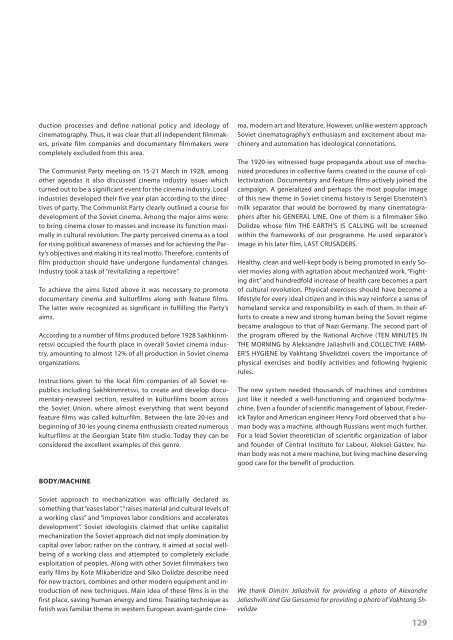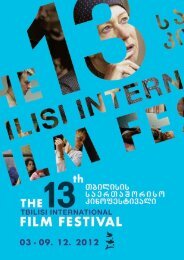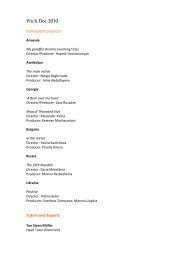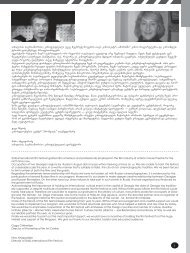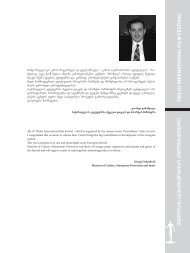supervarskvlavi safrangeTi 2012
supervarskvlavi safrangeTi 2012
supervarskvlavi safrangeTi 2012
Create successful ePaper yourself
Turn your PDF publications into a flip-book with our unique Google optimized e-Paper software.
duction processes and define national policy and ideology of<br />
cinematography. Thus, it was clear that all independent filmmakers,<br />
private film companies and documentary filmmakers were<br />
completely excluded from this area.<br />
The Communist Party meeting on 15-21 March in 1928, among<br />
other agendas it also discussed cinema industry issues which<br />
turned out to be a significant event for the cinema industry. Local<br />
industries developed their five year plan according to the directives<br />
of party. The Communist Party clearly outlined a course for<br />
development of the Soviet cinema. Among the major aims were:<br />
to bring cinema closer to masses and increase its function maximally<br />
in cultural revolution. The party perceived cinema as a tool<br />
for rising political awareness of masses and for achieving the Party’s<br />
objectives and making it its real motto. Therefore, contents of<br />
film production should have undergone fundamental changes.<br />
Industry took a task of “revitalizing a repertoire”.<br />
To achieve the aims listed above it was necessary to promote<br />
documentary cinema and kulturfilms along with feature films.<br />
The latter were recognized as significant in fulfilling the Party’s<br />
aims.<br />
According to a number of films produced before 1928 Sakhkinmretsvi<br />
occupied the fourth place in overall Soviet cinema industry,<br />
amounting to almost 12% of all production in Soviet cinema<br />
organizations.<br />
Instructions given to the local film companies of all Soviet republics<br />
including Sakhkinmretsvi, to create and develop documentary-newsreel<br />
section, resulted in kulturfilms boom across<br />
the Soviet Union, where almost everything that went beyond<br />
feature films was called kulturfilm. Between the late 20-ies and<br />
beginning of 30-ies young cinema enthusiasts created numerous<br />
kulturfilms at the Georgian State film studio. Today they can be<br />
considered the excellent examples of this genre.<br />
BODY/MACHINE<br />
Soviet approach to mechanization was officially declared as<br />
something that “eases labor”, “raises material and cultural levels of<br />
a working class” and “improves labor conditions and accelerates<br />
development”. Soviet ideologists claimed that unlike capitalist<br />
mechanization the Soviet approach did not imply domination by<br />
capital over labor; rather on the contrary, it aimed at social wellbeing<br />
of a working class and attempted to completely exclude<br />
exploitation of peoples. Along with other Soviet filmmakers two<br />
early films by Kote Mikaberidze and Siko Dolidze describe need<br />
for new tractors, combines and other modern equipment and introduction<br />
of new techniques. Main idea of these films is in the<br />
first place, saving human energy and time. Treating technique as<br />
fetish was familiar theme in western European avant-garde cine-<br />
ma, modern art and literature. However, unlike western approach<br />
Soviet cinematography’s enthusiasm and excitement about machinery<br />
and automation has ideological connotations.<br />
The 1920-ies witnessed huge propaganda about use of mechanized<br />
procedures in collective farms created in the course of collectivization.<br />
Documentary and feature films actively joined the<br />
campaign. A generalized and perhaps the most popular image<br />
of this new theme in Soviet cinema history is Sergei Eisenstein’s<br />
milk separator that would be borrowed by many cinematographers<br />
after his GENERAL LINE. One of them is a filmmaker Siko<br />
Dolidze whose film THE EARTH’S IS CALLING will be screened<br />
within the frameworks of our programme. He used separator’s<br />
image in his later film, LAST CRUSADERS.<br />
Healthy, clean and well-kept body is being promoted in early Soviet<br />
movies along with agitation about mechanized work. “Fighting<br />
dirt” and hundredfold increase of health care becomes a part<br />
of cultural revolution. Physical exercises should have become a<br />
lifestyle for every ideal citizen and in this way reinforce a sense of<br />
homeland service and responsibility in each of them. In their efforts<br />
to create a new and strong human being the Soviet regime<br />
became analogous to that of Nazi Germany. The second part of<br />
the program offered by the National Archive (TEN MINUTES IN<br />
THE MORNING by Aleksandre Jaliashvili and COLLECTIVE FARM-<br />
ER’S HYGIENE by Vakhtang Shvelidze) covers the importance of<br />
physical exercises and bodily activities and following hygienic<br />
rules.<br />
The new system needed thousands of machines and combines<br />
just like it needed a well-functioning and organized body/machine.<br />
Even a founder of scientific management of labour, Frederick<br />
Taylor and American engineer Henry Ford observed that a human<br />
body was a machine, although Russians went much further.<br />
For a lead Soviet theoretician of scientific organization of labor<br />
and founder of Central Institute for Labour, Aleksei Gastev, human<br />
body was not a mere machine, but living machine deserving<br />
good care for the benefit of production.<br />
We thank Dimitri Jaliashvili for providing a photo of Alexandre<br />
Jaliashvilli and Gia Gersamia for providing a photo of Vakhtang Shvelidze<br />
129


